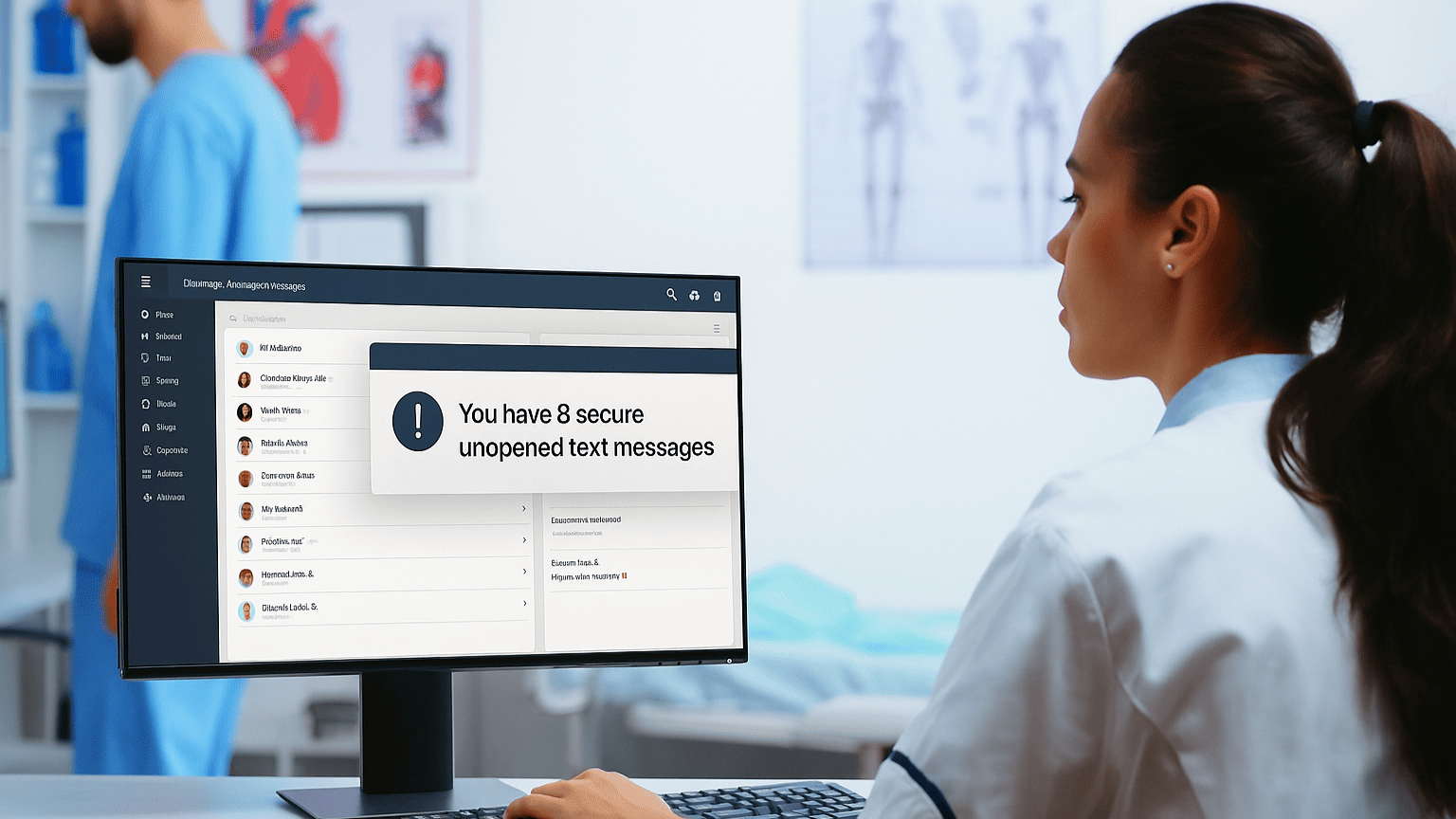Examples of HIPAA-Compliant Texting Workflows in Practice Fusion
💡 HIPAA-compliant texting in Practice Fusion helps small clinics enhance their workflows. With secure texting, they can improve efficiency, reduce...
7 min read
Gregory Vic Dela Cruz : Sep 16, 2025 11:00:00 AM

Practice Fusion has become a trusted EMR for thousands of medical practices. It's known for affordability, accessibility, and user-friendly design. But while it streamlines clinical charting, many practices still struggle with disconnected systems. That's because their patient engagement and administrative tasks reside outside the EMR. Staff juggle phones, paper forms, and disconnected tools that cause frustration. Missed appointments, unclear instructions, and compliance blind spots remain daily challenges.
That’s where HIPAA-compliant texting for Practice Fusion comes in. Instead of endless calls, patients get clear reminders they can respond to instantly. Intake forms, consents, and even payments sync back to the chart. Every interaction is logged automatically for compliance. The result? Fewer no-shows, calmer front desks, and more predictable schedules.
This blog explores how Curogram’s HIPAA-compliant platform seamlessly connects with Practice Fusion. We’ll cover the following topics:
Whether you’re a small clinic or multi-location, integration can transform your operations. Read on to learn how you can put the patient experience first while increasing your revenue.
HIPAA-compliant texting is secure, two-way electronic messaging that transmits, receives, and stores protected health information (PHI) under appropriate administrative, physical, and technical safeguards. In practice, that means encryption in transit and at rest, role-based access, identity and access management, message retention, and a complete audit trail mapped to the patient record. These safeguards align to the core expectation that clinics protect confidentiality, integrity, and availability of electronic PHI through reasonable, documented controls.
Consumer texting apps lack the controls required to protect PHI. Messages aren’t consistently encrypted end-to-end, there’s no standardized way to restrict who can access the conversation, and nothing ensures messages are logged for auditing. Even when staff avoid explicit PHI, context can still reveal sensitive information. This is why using personal phones or unlogged channels creates avoidable compliance risk—no access controls, no centralized logging, and gaps in documentation.
A healthcare-grade, HIPAA-aligned messaging platform closes those gaps. Core capabilities include:
When a secure platform is integrated to your EHR, Practice Fusion patient communication tools become faster and safer: staff text from a shared, HIPAA-logged inbox; patients reply on any device; and everything lands where it belongs—inside the record. The result is simpler compliance and better experience for patients and staff alike.
Front desks spend hours on status updates, reschedules, and FAQs. Without secure texting, routine calls queue up, staff are interrupted, and documentation suffers. Clinics that move common workflows to HIPAA-logged messaging routinely cut routine phone traffic by ~40–50%, freeing hours weekly for higher-value tasks.
Mobile-first patients expect timely, actionable messages—confirmations, prep, links, and directions—without logging into portals. Secure texting meets patients where they are while maintaining safeguards missing from consumer SMS. It raises responsiveness and satisfaction while keeping communications centralized and retrievable.
When conversations happen on personal phones or unlogged channels, your audit trail breaks—and so does trust. The biggest compliance risks in disconnected systems include unsecured communications, missing documentation, and EHR silos. A HIPAA-compliant messaging solution centralizes conversations, automates logging, and maps messages and forms to the chart, reducing exposure and audit prep time dramatically.
Bottom line: for secure texting Practice Fusion workflows, a HIPAA-grade platform is the pragmatic path to faster responses, fewer calls, lower no-shows, and defensible compliance.
Generic robocalls don’t move behavior; EMR-aware reminders do. When reminders read live schedule data (provider, location, visit type) and include one-tap actions (confirm, reschedule, add-to-calendar), patients respond faster and show up prepared. Clinics that align reminder cadence to appointment type—e.g., 3 days, 24 hours, 2 hours—consistently recover at-risk slots and reduce missed visits. Two-way confirmations let staff backfill openings quickly, and every reply is captured in a HIPAA-logged thread for the record.
Missteps before the visit cause day-of cancellations: fasting missed, forms incomplete, insurance cards forgotten. Secure texts with tailored prep (“fast 8 hours,” “arrive 15 minutes early,” “complete forms here”) cut those preventable failures. Mobile intake captures demographics, consents, and insurance uploads in minutes; on submission, data syncs to the chart to eliminate retyping and scanning. The payoff is shorter check-ins, fewer errors, and providers walking in with complete context.
After-hours calls can’t always be answered live, but they can be acknowledged. An after-hours auto-reply sets expectations (“We’ll reply by 8:00 a.m.”), routes emergencies appropriately, and logs the outreach. Next day, staff triage from a single inbox instead of chasing voicemails. Post-visit follow-ups—medication checks, wound-care tips, or “How are you feeling today?” micro-surveys—surface issues early and demonstrate continuity of care. Structured, documented follow-ups help close common handoff gaps and improve safety.
Experience drives growth. A quick, post-visit feedback link identifies issues for service recovery and, when appropriate, routes happy patients to public review sites. Practices that automate feedback see more five-star reviews and faster resolution of concerns, boosting online visibility and retention.
Patients often need quick clarifications—refill status, lab scheduling, or prep do’s and don’ts. With a HIPAA-logged, role-based inbox, staff answer in seconds using templates that include links or instructions. Because messages are attached to the encounter, providers see what was promised and why. This avoids repeat questions and keeps the team synchronized.
Texting isn’t just faster—it’s safer when done right. Secure platforms capture message metadata (sender, recipient, timestamp), attach it to the chart, and store it per retention policy. That makes audits and payer reviews dramatically simpler and reduces denials tied to “missing documentation”. In contrast, consumer SMS lacks access controls, centralized logging, and archival guarantees—creating avoidable risk.
Practice Fusion’s user base includes many small and independent practices. A safe texting platform for small clinics must be fast to adopt (minutes, not weeks), easy to learn (familiar texting UX), and flexible enough to mirror your workflows. Look for templates per appointment type, language options, and simple routing rules. Just as important, ensure your vendor offers a signed BAA, clear retention settings, and SOC 2/HIPAA attestations to complement your internal policies.

One of the strongest advantages of adding HIPAA-compliant texting to Practice Fusion is how it removes manual bottlenecks and connects staff, patients, and providers seamlessly. The front desk gains back hours of time each week, while patients receive clearer, timelier communication that keeps them on track with care.
By shifting routine confirmations and FAQs to text, practices cut phone traffic nearly in half. Patients appreciate being able to send a quick reply rather than waiting on hold, and staff can manage multiple conversations at once without missing details.
Digital forms linked to the EMR allow patients to complete intake before arrival. Information flows automatically into Practice Fusion, eliminating duplicate entry and reducing billing errors downstream. This increases provider throughput and improves the patient experience at check-in.
Every message is encrypted, time-stamped, and stored in the EMR, creating a permanent audit trail. This makes compliance automatic instead of staff-dependent, reducing risk and increasing confidence during audits.
Curogram enables secure, two-way texting directly connected to Practice Fusion’s scheduling data. Patients can confirm, reschedule, or ask questions instantly, while staff see appointment context in real time. Every message is logged back into the chart, ensuring compliance and eliminating missed details.
Because Curogram integrates with live schedule data, reminders and intake forms always reflect the latest information. If a provider changes locations or appointment times shift, patients automatically receive updated instructions. This prevents confusion, missed appointments, and same-day cancellations.
Curogram is both SOC 2 and HIPAA certified, meaning it meets the strictest standards for security and data handling. This ensures that every communication—whether a reminder, intake form, or text-to-pay message—meets compliance requirements. For administrators, it means fewer headaches and stronger trust with both patients and regulators.
By integrating directly with Practice Fusion, Curogram turns the EMR into a complete engagement hub. The combination of automation, secure messaging, and compliance safeguards creates measurable wins for both staff and patients.
Patients want speed; administrators need compliance; staff need time back. HIPAA-compliant texting for Practice Fusion users delivers all three. With a secure, integrated platform, you replace phone tag with two-way messaging.
Choosing the right partner matters. Look for encryption, BAAs, retention controls, and seamless sync to Practice Fusion. Nice to haves include templates, language support, and analytics you can act on. Curogram was built for this reality.
With Curogram, you can add EMR-aware reminders that actually change behavior. Plus, you can capture every interaction in a defensible audit trail. The effects compound: fewer no-shows, shorter check-ins, calmer mornings, stronger reviews. You'll have a team that spends more time helping people than chasing voicemails.
Want HIPAA-compliant texting that integrates with Practice Fusion? Get a demo today.

💡 HIPAA-compliant texting in Practice Fusion helps small clinics enhance their workflows. With secure texting, they can improve efficiency, reduce...

💡 In Practice Fusion, patient communication through text messaging gives clinics a powerful tool. This simple solution reduces missed calls, cuts...

💡HIPAA-compliant texting for Athenahealth users lets clinics communicate securely with patients. Staff can send reminders, instructions, and...